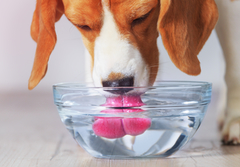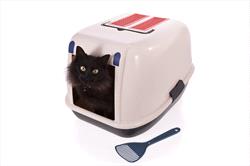
Photo Courtesy Adobe/Shutterstock
Polyuria and polydipsia are essentially flip sides of the same condition. With polyuria (PU) the body makes more urine than normal, which in turn causes a condition called polydipsia (PD), which means your dog or cat is extra thirsty because they are trying to stay hydrated. What goes out must be replaced by what goes in. But it is equally true that what goes in must go out as well, although sometimes water taken in goes out through panting, especially in dogs.
How much water your pet regularly drinks can vary from day to day, but when a pattern of more than usual intake and outtake occurs, PU/PD is a possible, if not likely, cause. Finding out the cause involves your veterinarian looking at your pet’s patterns and running some tests.
How Does PU/PD Happen?
It takes many body systems to control water intake and urine production. These systems include the thirst center, kidneys, pituitary gland, and hypothalamus, an area in the front of the brain. Changes in the volume of blood – which is mostly water - flowing through the body will also increase or decrease thirst.
Lack of water is not the only cause of PU/PD. Low blood pressure (hypotension), fever, pain, and certain medications can also cause your pet to be extra thirsty. These conditions cause the release of anti-diuretic hormones (ADH) from a small gland in the brain called the pituitary. ADH is important in keeping you and your pet hydrated. ADH binds to receptors in the kidneys to keep water in the body. When all is normal, the binding helps blood volume and blood pressure stay normal. If the kidneys are diseased or damaged, they will lose too much fluid. For example, if blood volume and pressure are too low, ADH is released, and the kidneys make less urine. If the blood pressure is normal, the pituitary does not release ADH.
Causes
Finding the cause for PU/PD is sometimes straightforward and other times quite difficult. Decreased release of ADH, a kidney’s failure to respond to ADH, or changes in the kidneys can cause PU/PD. The kidneys will release more water (urine), which will cause thirst, and your dog or cat will drink more.
Several conditions can produce this problem in dogs and cats. The most common causes in dogs are chronic kidney disease, hyperadrenocorticism (Cushing’s disease), and diabetes mellitus. In cats, the most common causes also include chronic kidney disease and diabetes mellitus, but also hyperthyroidism. There are, however, other possible causes.
Drugs that can cause PU/PD include glucocorticoids, phenobarbital, and diuretics. Salt can be a contributor.
Diagnosis

Photo Courtesy VIN/Bigstock Images
To diagnose PU/PD, your veterinarian will start with a thorough physical examination, take your pet’s history, and likely run some laboratory tests, including a complete blood count, serum biochemistry panel, urinalysis, and urine culture. The background you supply in your pet’s history may help your veterinarian track down the cause of the PU/PD.
Testing the pet’s urine helps show if the kidneys are working properly. Kidneys concentrate urine by keeping water in the body. Veterinarians will measure this urine concentration, which is called specific gravity. This measurement may show what is causing the PU/PD. Urine concentration, also called USG, is a substitute test for urine volume. Measuring daily urine output is hard in pets, whereas measuring their USG is easy. High volumes of urine are seen when the animal has a low urine concentration.
Other blood tests that can help pinpoint the causes of PU/PD include measuring bile acids before and after eating, tests for Addison’s or Cushing’s disease, thyroid, and blood sugar (glucose) levels in the body, as well as testing for infectious diseases, such as Leptospirosis.
If your veterinarian suspects a rare disease called diabetes insipidus, which causes the body to make too much urine, other tests will be needed. Diabetes insipidus is not related to diabetes mellitus, which is only a problem with blood sugar.
Ultrasound and X-rays are helpful when looking for cancer, pyometra, or abnormalities in the adrenal glands.
PU/PD can have many causes. The most common ones are fairly simple to diagnose but be prepared for a more extensive workup if the typical causes are not found. Luckily, many of the causes can be successfully managed.